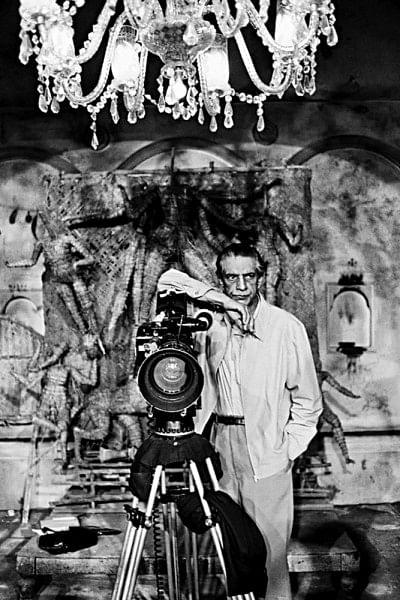Satyajit Ray: A director's gaze

A pair of keen eyes put Simi Garewal on edge at a wedding reception of Raj Kapoor's daughter. Little did the teenager in her trendy outfit know that the eyes following her were none other than Satyajit Ray's. She had even less idea that in his mind Ray was already visualising her in the role of a tribal girl in his upcoming film "Aranyer Din Ratri". The art of seeing past one's worldly looks and recasting them in light of their inner talent was not unknown to Ray.
The role required four hours of gruelling makeover every day for the young actor. The first slot of shooting continued for 15 days in a tribal locality in the blazing April summer in a Bihar forest. The place was devoid of electricity or even modern bathrooms. The nearest well served as the only source of water supply. Deep inside the forest, the only available menu included potatoes and rice but even that seemed like a picnic to the cast and crew, with "Manik Da" Ray waving his magic wand.
After a hectic shooting schedule, the evenings were reserved for Manik Da to play a word game with Simi while the rest indulged in Tagore songs and chitchat. Simi came from Punjab but learnt Bengali in a span of three months and developed a lasting bond between Ray and the cast. The Bengali adventure drama, released in 1970, and written and directed by Satyajit Ray, was nominated for the Golden Bear for Best Film at the 20th Berlin International Film Festival.
That was of course not all that there was about Ray. His first film "Pather Panchali" had won 11 international prizes. Long before the concept of trilogy caught the movie industry's imagination, Ray's trilogy—Apu—premiered in the 1950s. He was the first Bengali (or Indian) to receive the Academy Honorary Award in 1992 for his tremendous impact on film making. Ray also became only the second film personality after Chaplin to have been awarded an honorary doctorate degree by Oxford University.
Satyajit Ray also received numerous awards and honours, including India's highest award in cinema, the Dadasaheb Phalke Award (1984), and India's highest civilian award, Bharat Ratna (1992). He was also awarded the Commander of the National Order of the Legion of Honour, the highest decoration in France (1987).
Legendary actor Soumitra Chatterjee once recalled that if "Apur Songshar" was the turning point of his acting career, "Charulata"—one of Ray's favourites and an all-time classic—saw him reach his peak in the art of longhand. The role required Soumitra to develop his skills in calligraphy. Ray drafted a sample of pre-Tagore era calligraphy on which Soumitra would practice every day for six months before the shooting commenced. The scrutiny he subjected his films to was without precedence.
He created two lasting popular characters in Bengali literature—the debonair detective Felu Da and the brilliant scientist Professor Shonku. The brilliance of Sir Arthur Conan Doyle and Isaac Asimov neatly packed into one creative mind that was Ray's.
His other characters in films were no less evergreen. "Goopi Gayen Bagha Bayen" and "Hirak Rajar Deshe" are timeless films that brought to life heroes and villains through humour, tragedy and captivating storytelling. Often thorny social issues found their way into the script, smartly woven together to highlight deeply-set ideologies and even taboos. "Aguntukh", "Ganashotru", "Mohapurush" were some such classics. Other masterpieces "Pather Panchali", "Aparajito", "Nayak", "Debi" and "Mahanagar" can still be seen as contemporary.
Such accolades, however, hardly affected Ray. His genius seemed to be matched by his humility. According to Bangladesh's leading actor Babita, "One of the most remarkable experiences working with Satyajit Ray in "Ashani Sanket" was when one day, while shooting, I had to cross a small bridge on foot. I had to take my slippers off and forgot to pick them up. When I turned around, I was shocked to see that Manik Da was carrying my slippers! This was a lesson in humility that I'd never forget."
Ray's world standing in cinema was evident from his stunning debut film "Pather Panchali" (1955). The black-and-white international award winning film—the first of the poignant "Apu Trilogy"—follows the life of an impoverished Brahmin family from a little village in West Bengal. Later came "Aparajito" (1956) and "Apur Sansar" (1959), the journey of young Apu from young boy to adulthood.
He was a prolific director. His work included such films as "Jalsaghar" (1958), "Devi" (1960), "Teen Kanya" (1961), "Charulata" (1964), "Shatranj Ke Khilari (1977), "Ghare Baire" (1984), "Ganashatru" (1989) and "Shakha Prashakha" (1991). Ray's last film was "Agantuk" (1991).
Ray was a true polymath. His masterclass writing and directing was accompanied by his meticulous designing (art, costumes), composing and collaboration with the likes of Pandit Ravi Shankar, Ustad Ali Akbar Khan and Ustad Vilayat Khan. He also designed the calligraphy for the opening credits, handled the cinematography and screenplay, composed the music and designed the posters for his film releases. A hands-off director he was not. He was also a self-taught painter and a contemporary author of Bengali literature.
He had a connection with Bangladesh as well. Few are aware that he wanted to make a film based on Bangladeshi novelist and short story writer Selina Hossain's novel "Hangor, Nodi, Grenade". The book was set against Bangladesh's Liberation War. That didn't happen for a variety of reasons, including disturbed political conditions after the assassination of the Father of the Nation Bangabandhu Sheikh Mujibur Rahman. Eventually, five years after Ray died in 1992, Bangladesh director Chashi Nazrul Islam made a film based on the novel in 1997.
Ray belonged to that rare group of geniuses whose touch turned even the mundane into gold.
From all your admirers, here is to remembering you on your 31st death anniversary. If only that magic wand of yours was to be found once more.










Comments